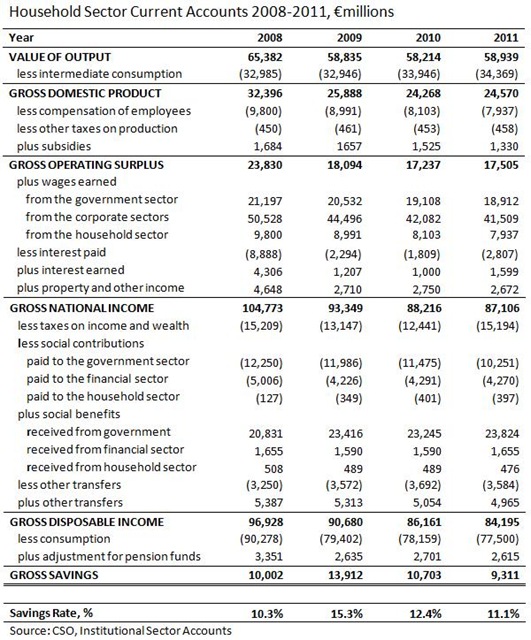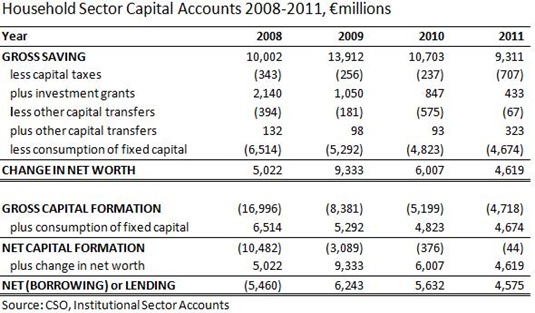A couple of recent posts have looked at the financial stocks of assets and liabilities in the household sector. The second part of the Institutional Sector Accounts is that which looks at non-financial flows; earnings, income, consumption and savings, investment and depreciation.
First, here are the figures for the household sector current account for the past four years.
For most of the aggregates there was very little change in 2011 on the 2010 figures. The large drops seen in 2009 and 2010 eased somewhat in 2011, but there is little sight of a comeback in these numbers.
Production (value of output) in the household sector rose slightly in 2011 leading to a small rise in the operating surplus of the sector (+1.6%). Wages paid to households (including employer’s PRSI) from the government, business and household sectors all declined in 2011, though at 1.3% the drop was the lower than previous years. These and other minor changes led to a decline of 1.3% in the Gross National Income of the household sector.
The aggregate that shows the largest change is "Taxes on Income and Wealth” which increased by 22.1% on the year. However, much of this is a reclassification change rather than an increased tax burden on households. In 2010, €2,018 million was collected via the Health Levy which was classified as a social contribution. For 2011, the Health Levy was abolished (along with the Income Levy) and replaced by the Universal Social Charge and all the revenue collected under the USC is classed as a tax rather than a social contribution.
Reflecting this social contributions paid to the government sector from households fell 10.7%. In 2010, social contributions paid to the government (all by the household sector) were €11.5 billion. For 2011, this was €10.3 billion. The remainder of the social contributions paid by the household sector were made to the financial sector (private pension contributions).
These were largely unchanged on the year at €4.3 billion. Social contributions to and from the household sector will be related to non-profit organisations which are included in the household sector.
In 2010, the total of income and wealth taxes and social contributions from the household sector paid to the government sector was €23.9 billion. For 2011, this increased to €25.4 billion. Social contributions paid from the government sector to the household sector were €23.8 billion, an increase of 2.5% on 2010.
The sum of these changes meant that the gross disposable income of the household sector declined from €86.2 billion in 2010 to €84.2 billion in 2011, a fall of 2.3%. From this household consumption was €77.5 billion, a decline of 0.8% on 2011.
Here are the capital accounts of the household sector.
The household sector has moved from being a net borrower to a net lender. This is largely as a result of the collapse in investment in non-financial assets by the household sector (buying new houses).
In 2008, gross capital formation by the household sector was €17 billion. This itself was down from €26 billion in 2006 and the fall continued through to 2011 when investment by the household sector was just over €4.7 billion. With depreciation of existing household capital slightly under €4.7 billion, the net capital formation of the household sector in 2011 was just €44 million. Repair of existing capital and investment in new capital barely covered the depreciation of existing capital.
The household sector is not using its gross savings to invest in fixed capital. Nor is the sector using it to build up deposits; it is going it to pay down debt.
Tweet




No comments:
Post a Comment